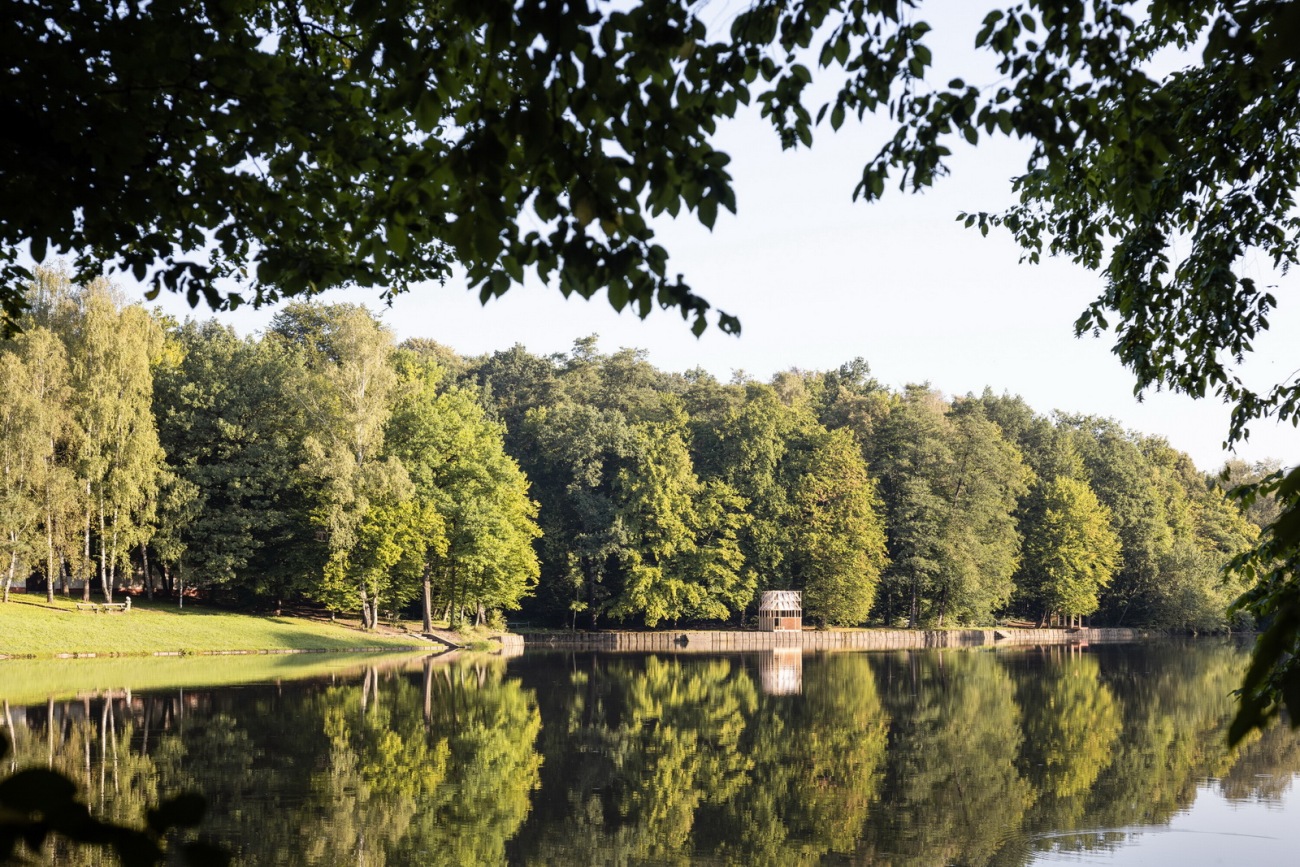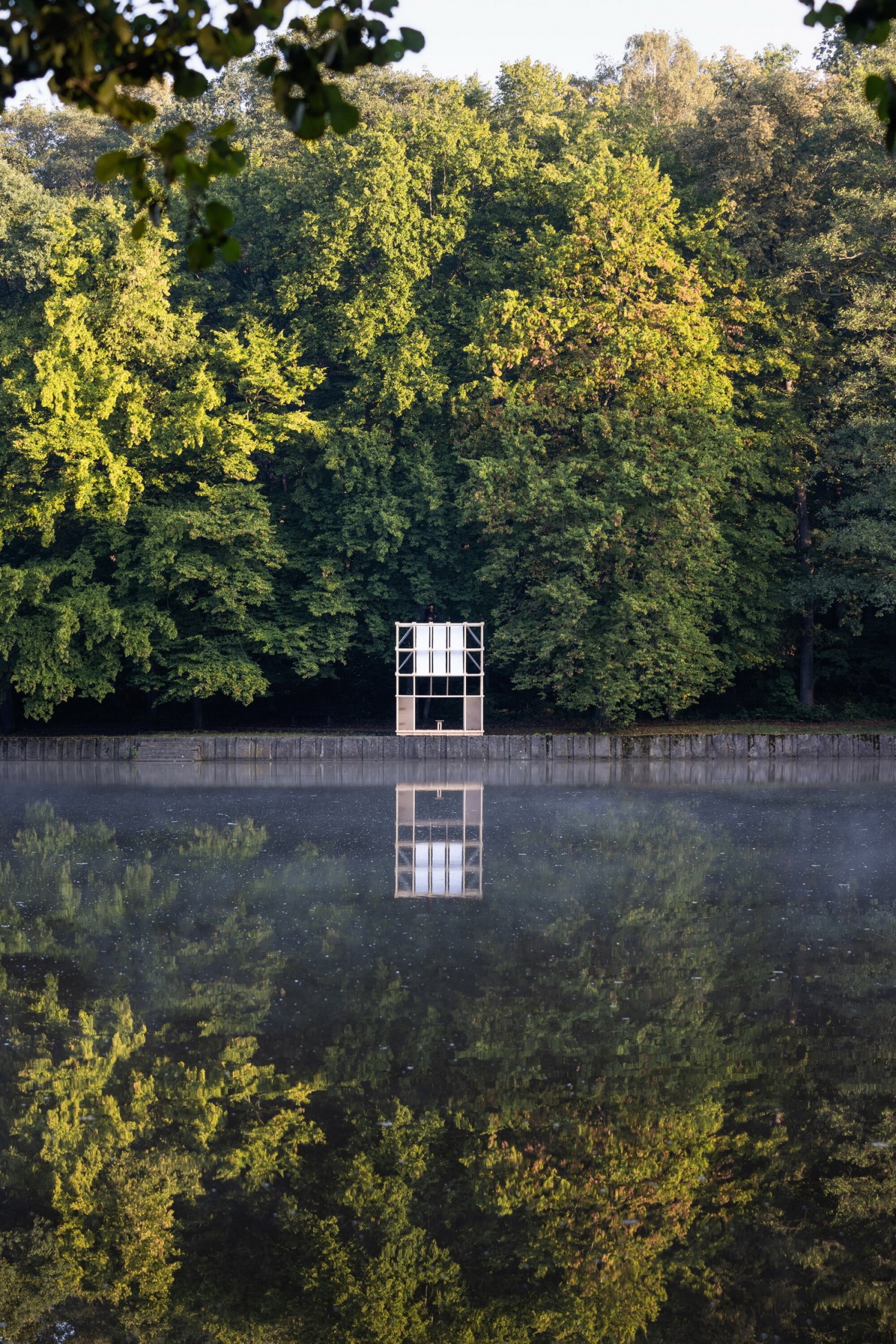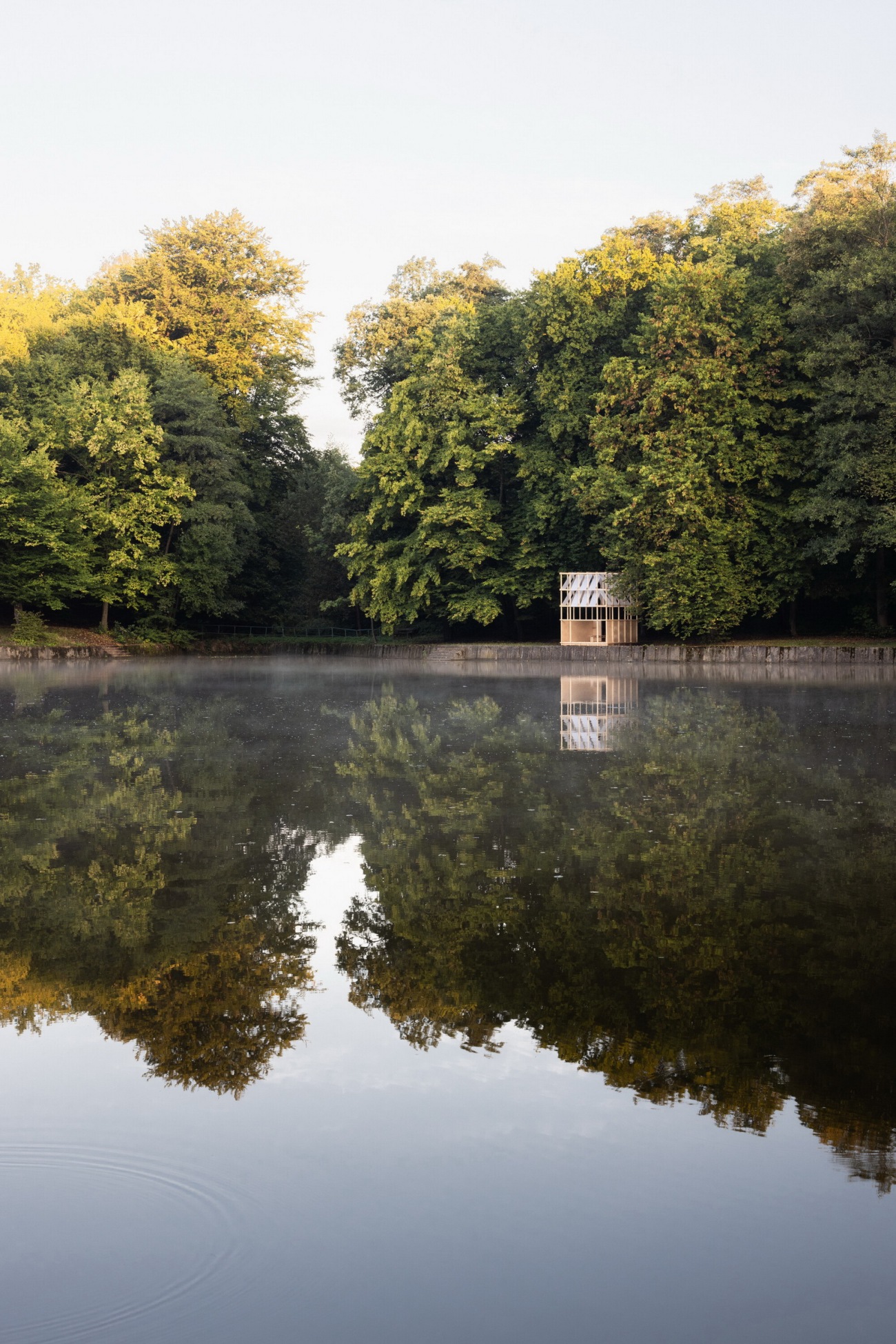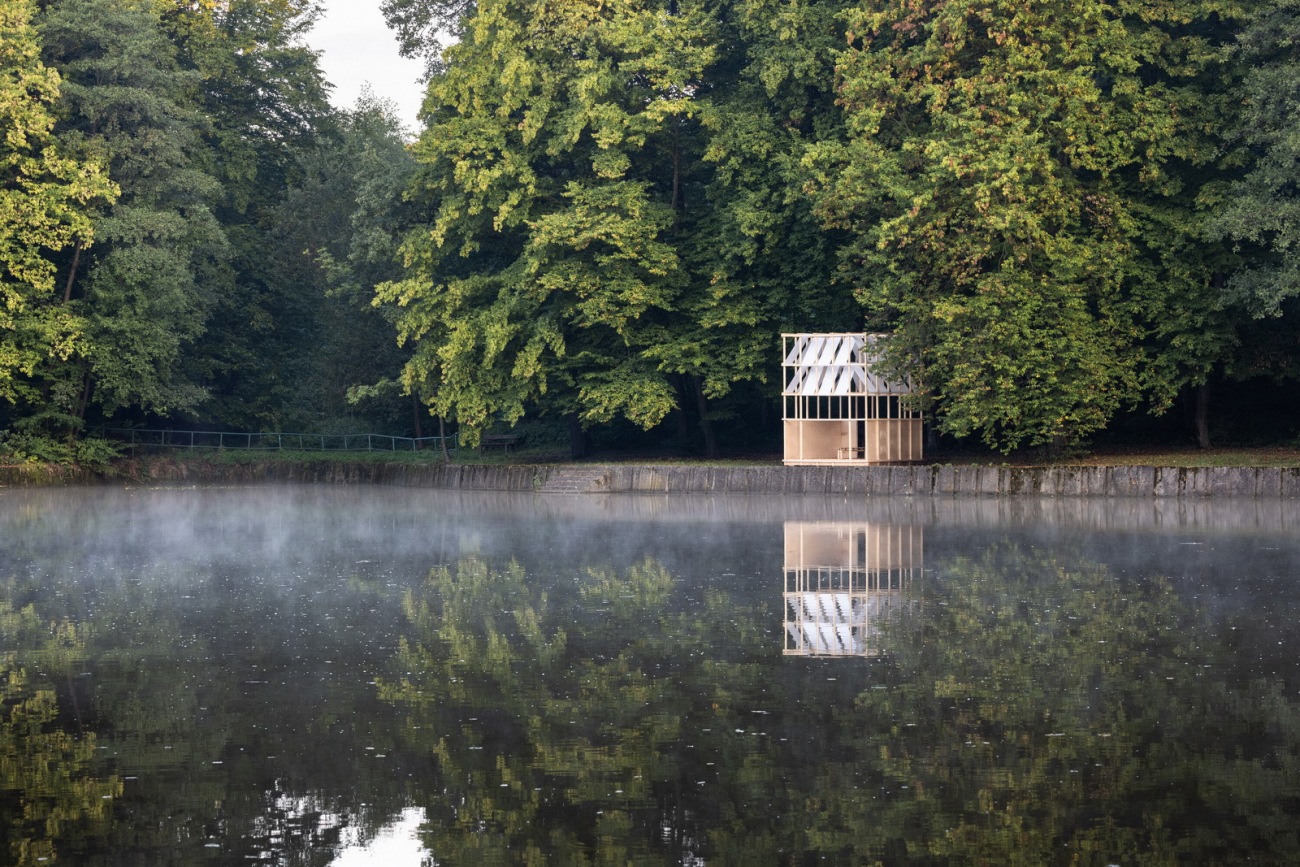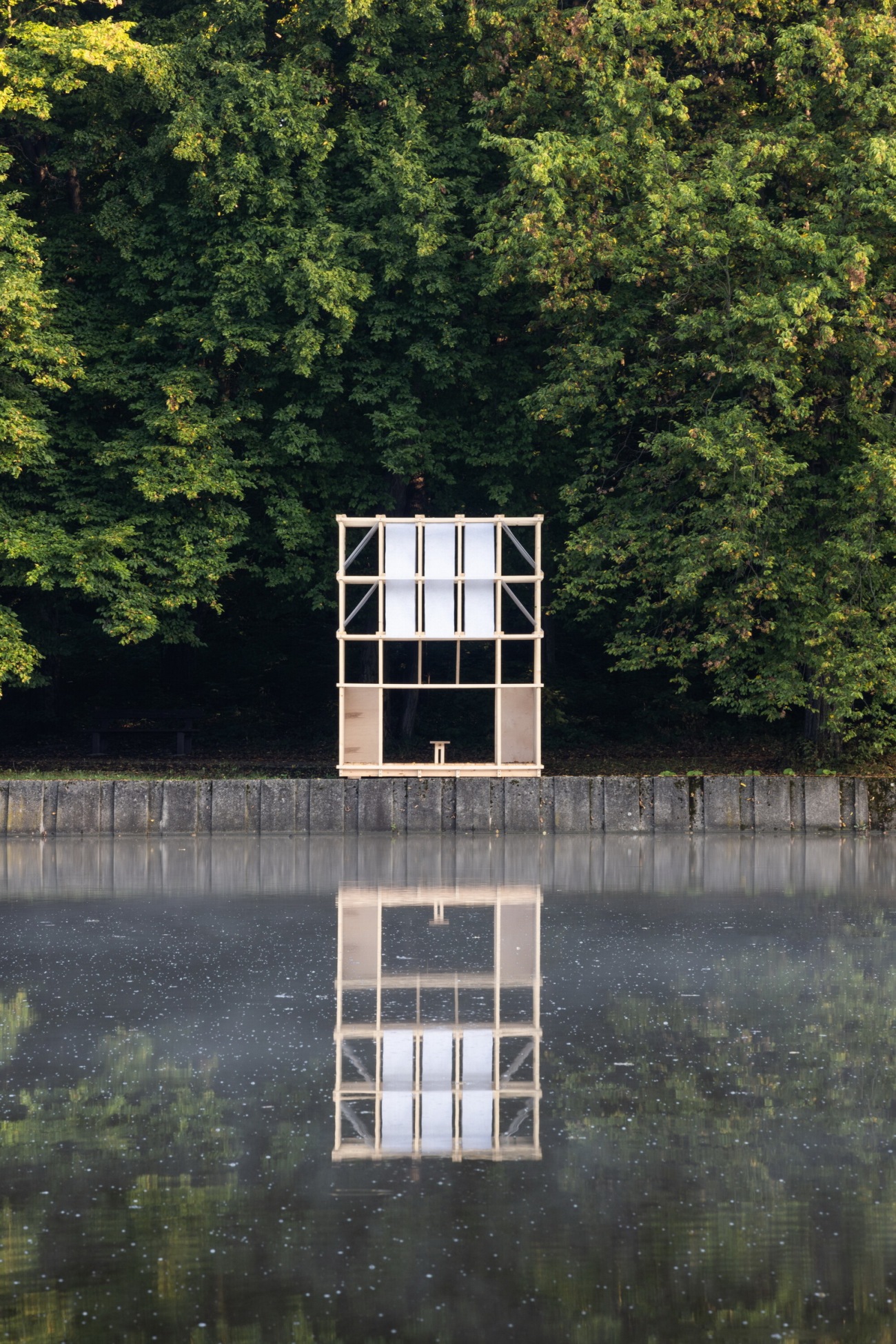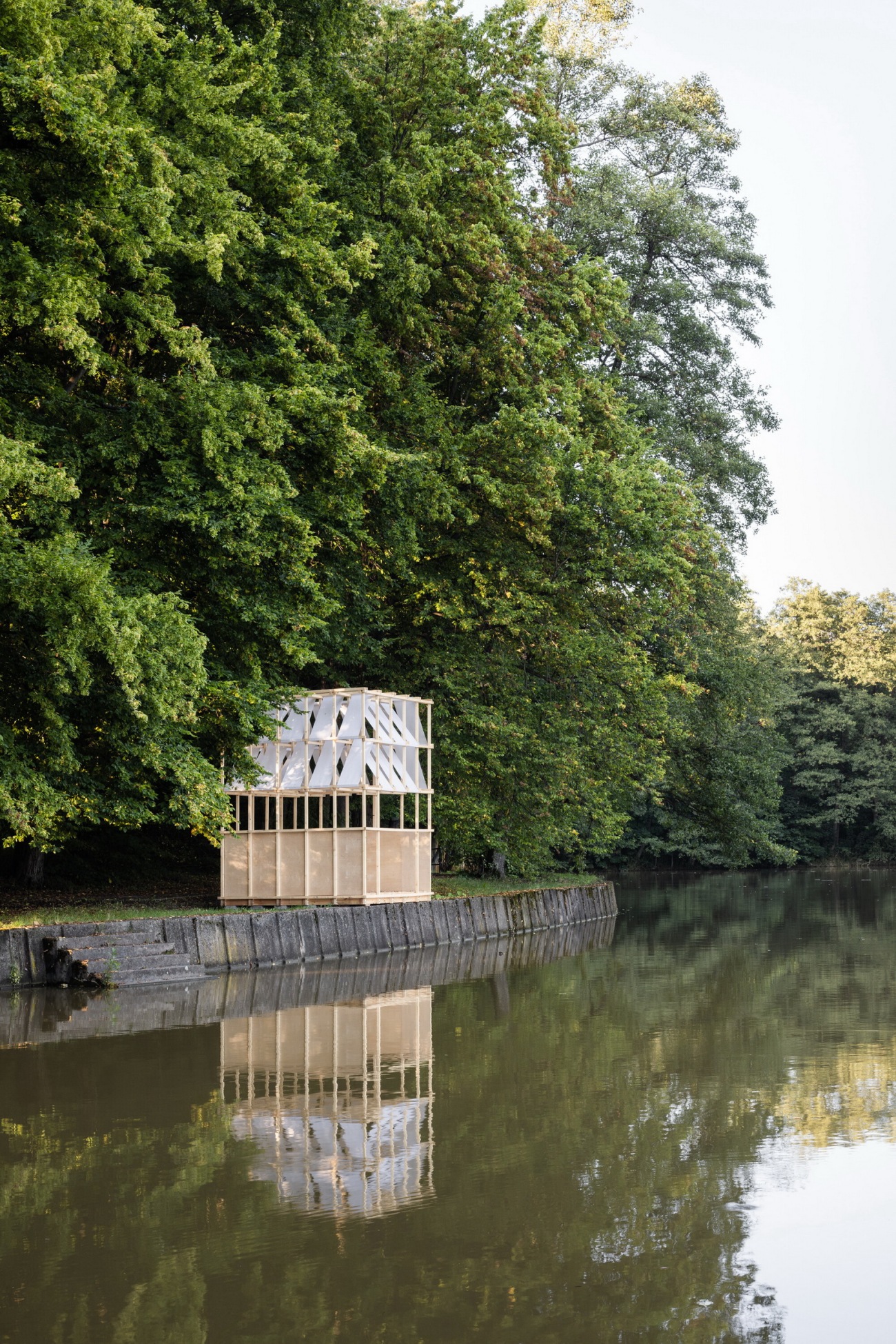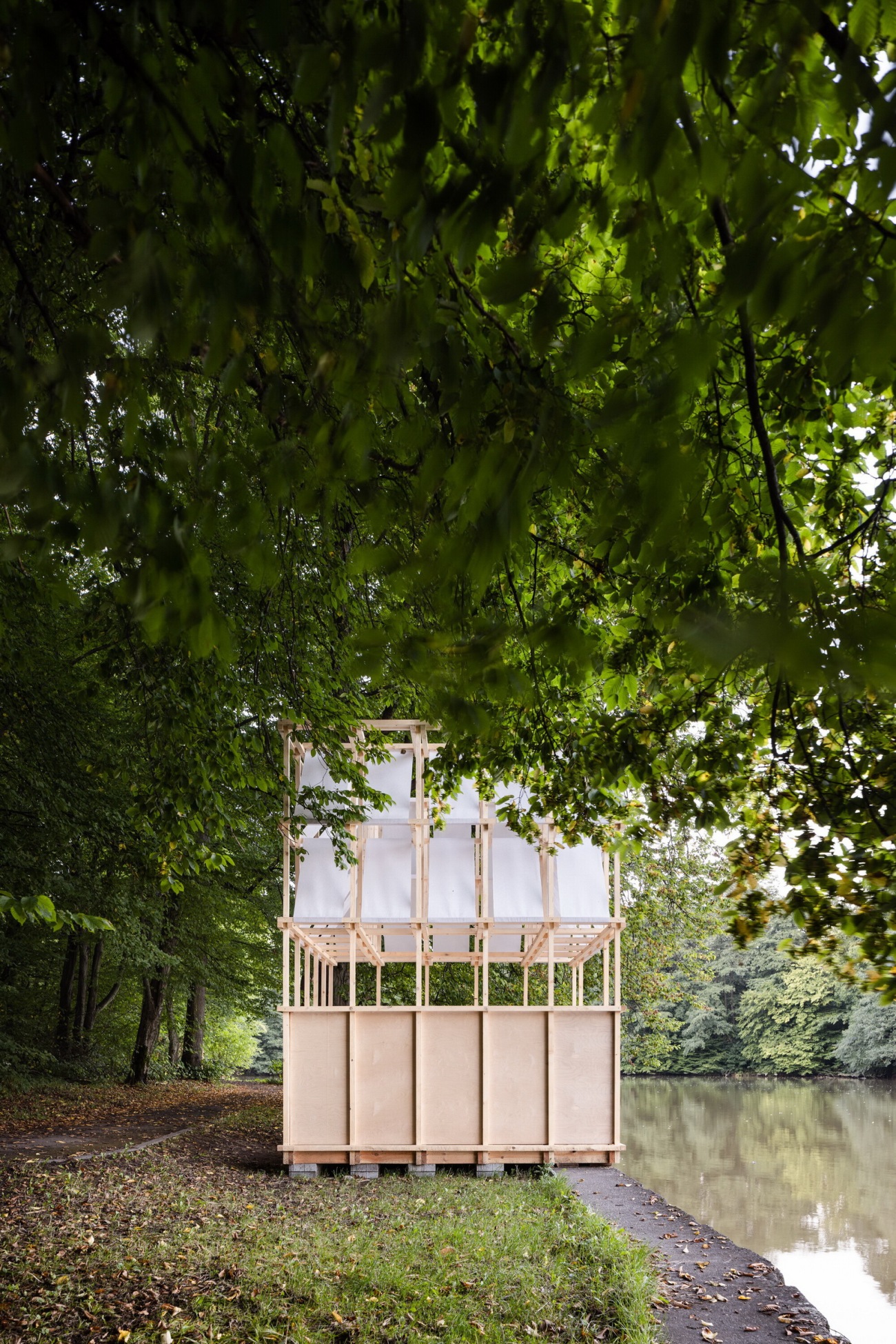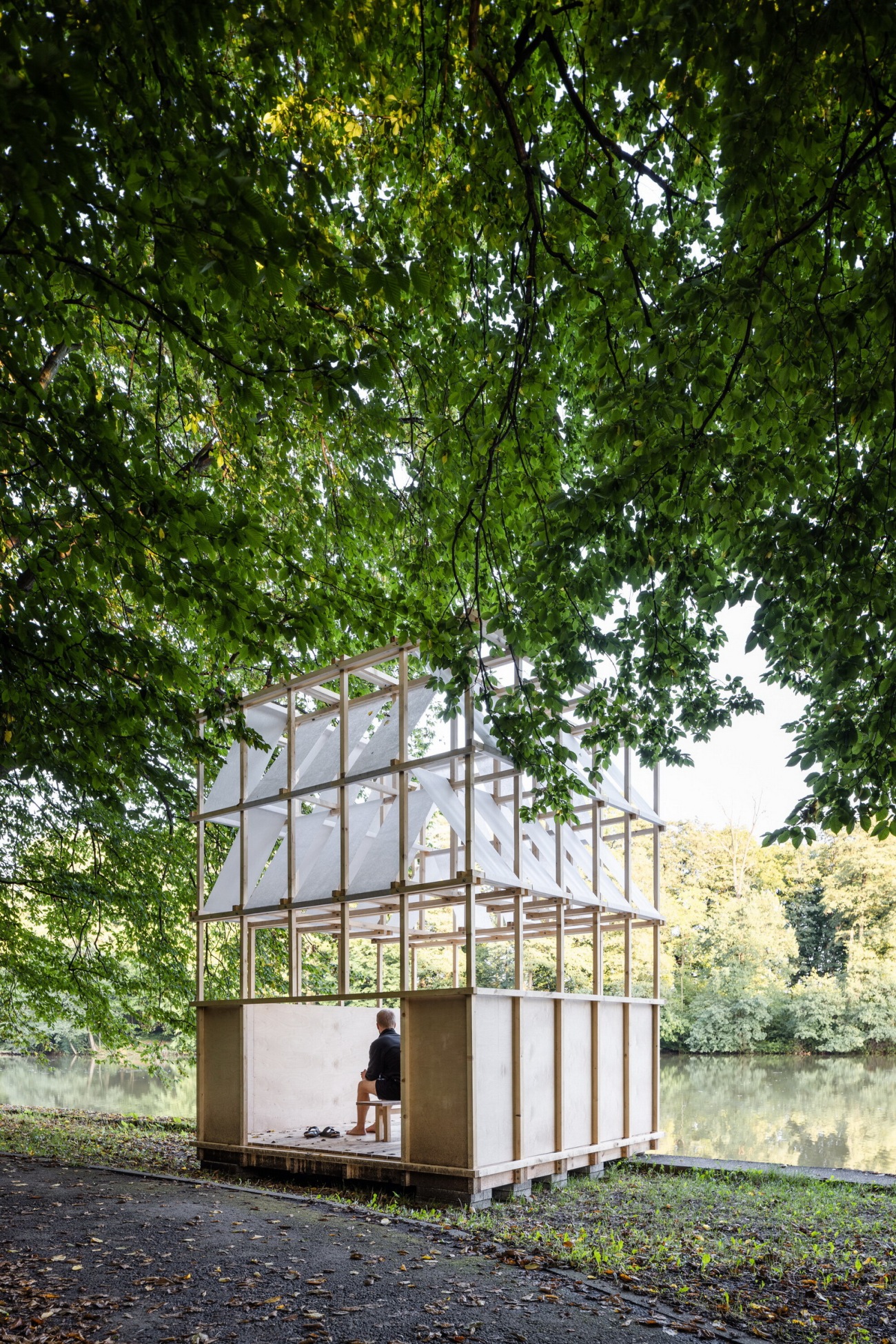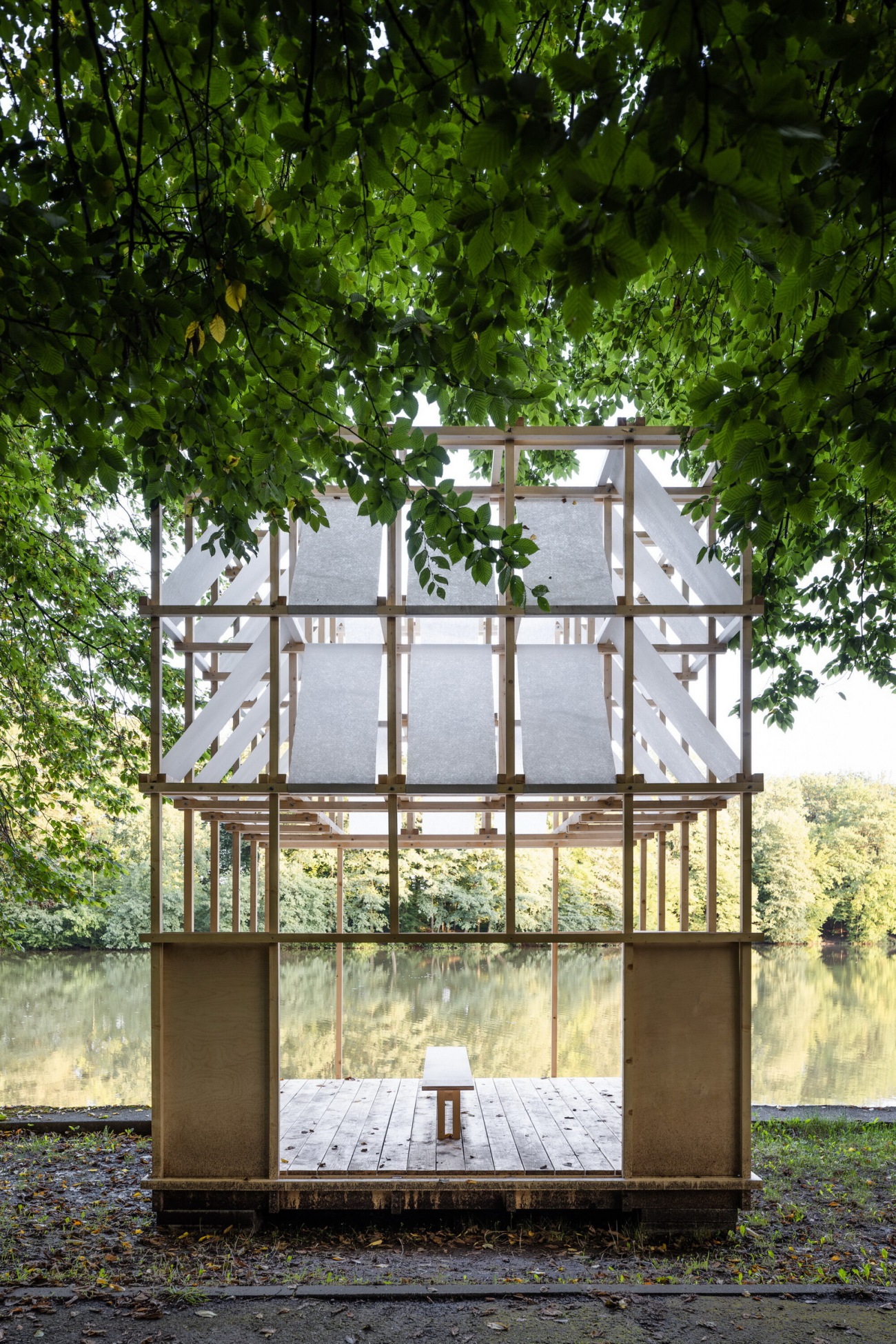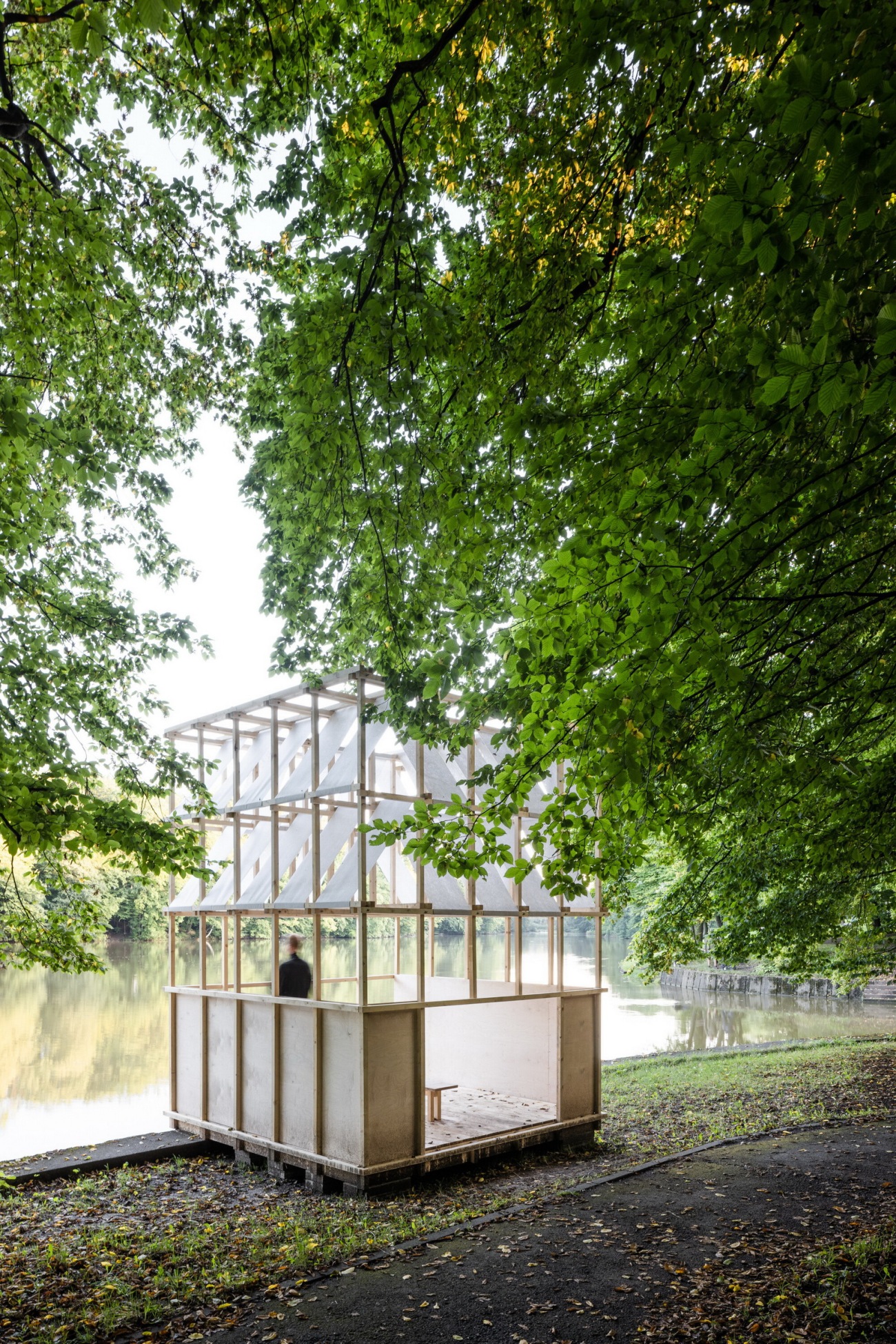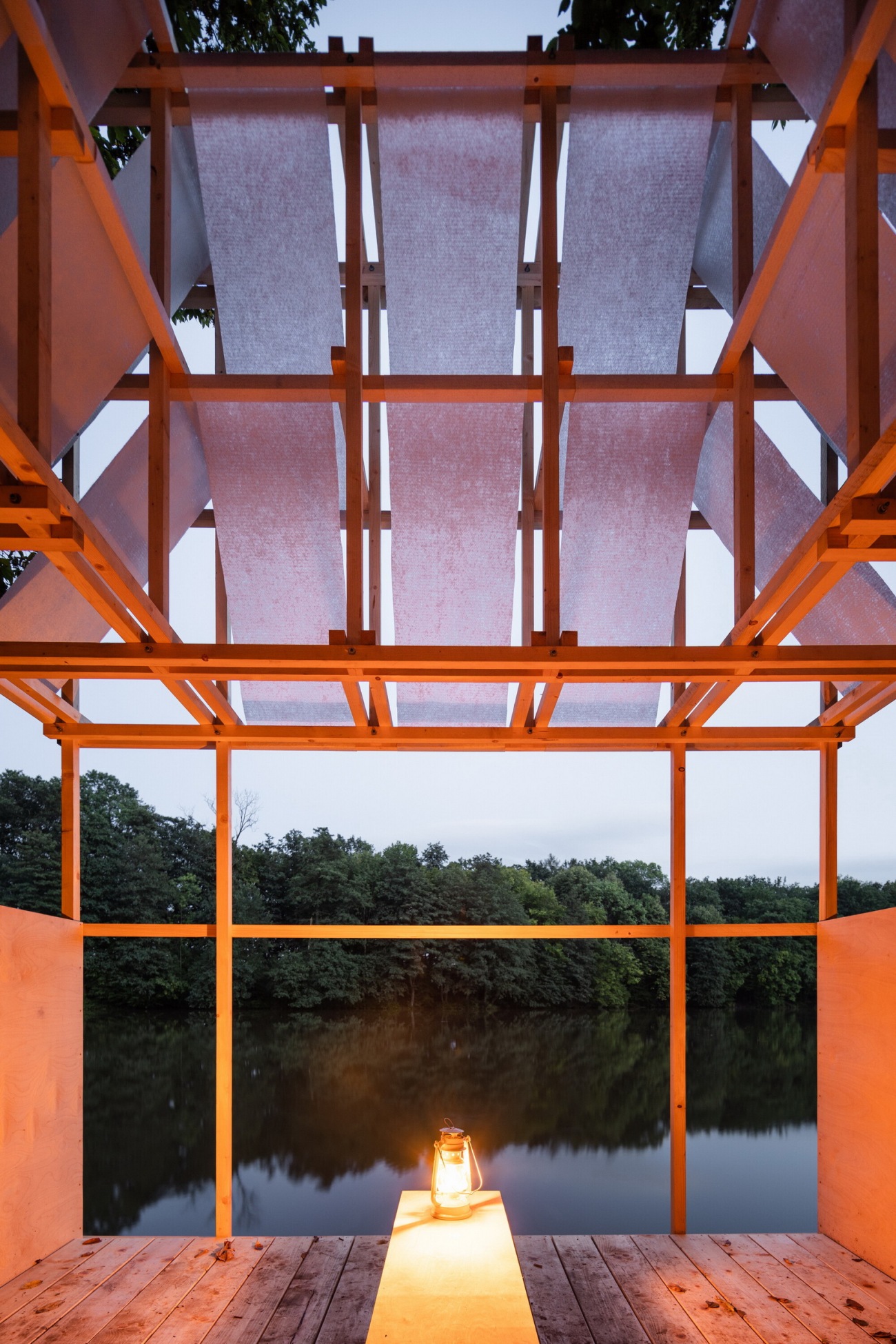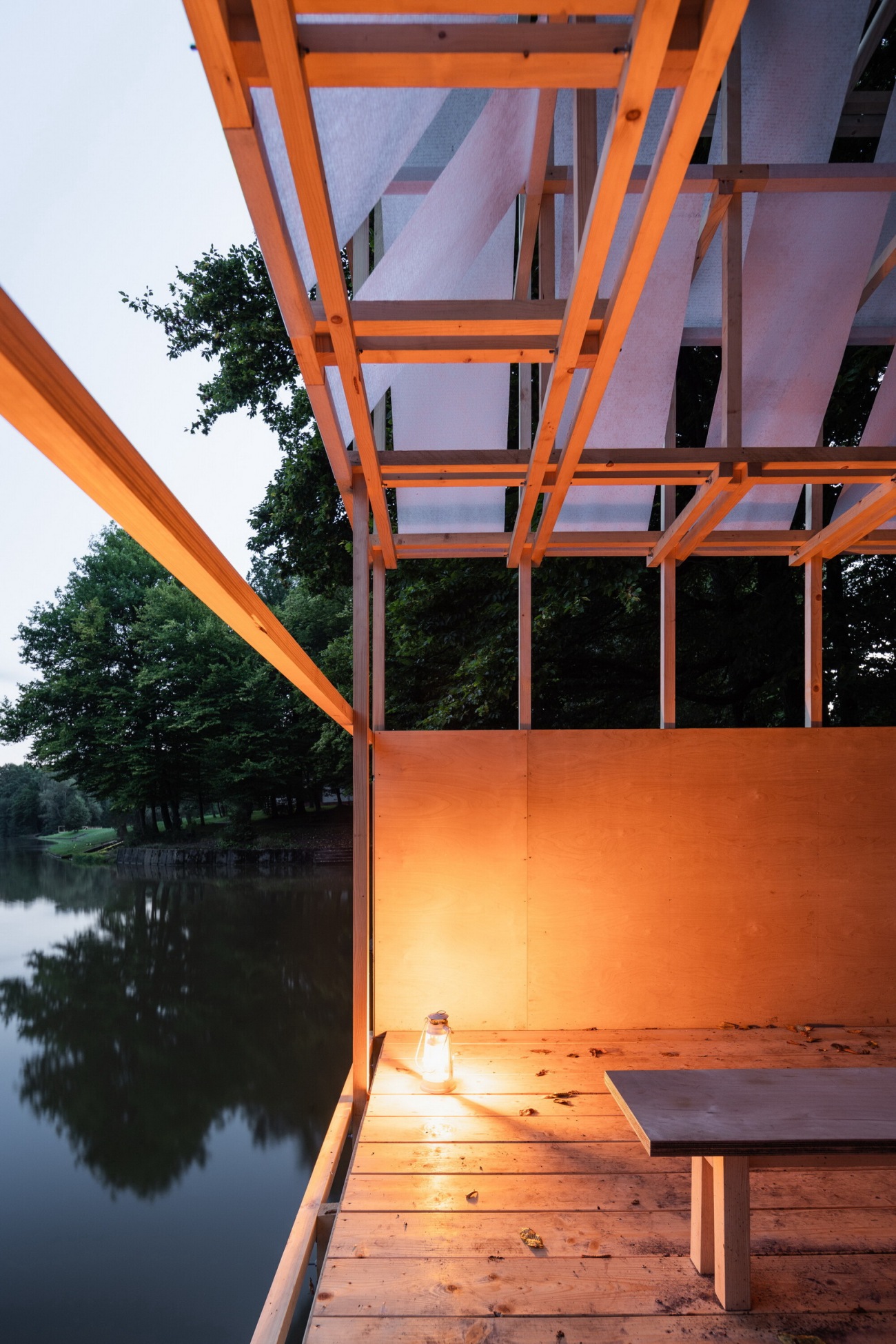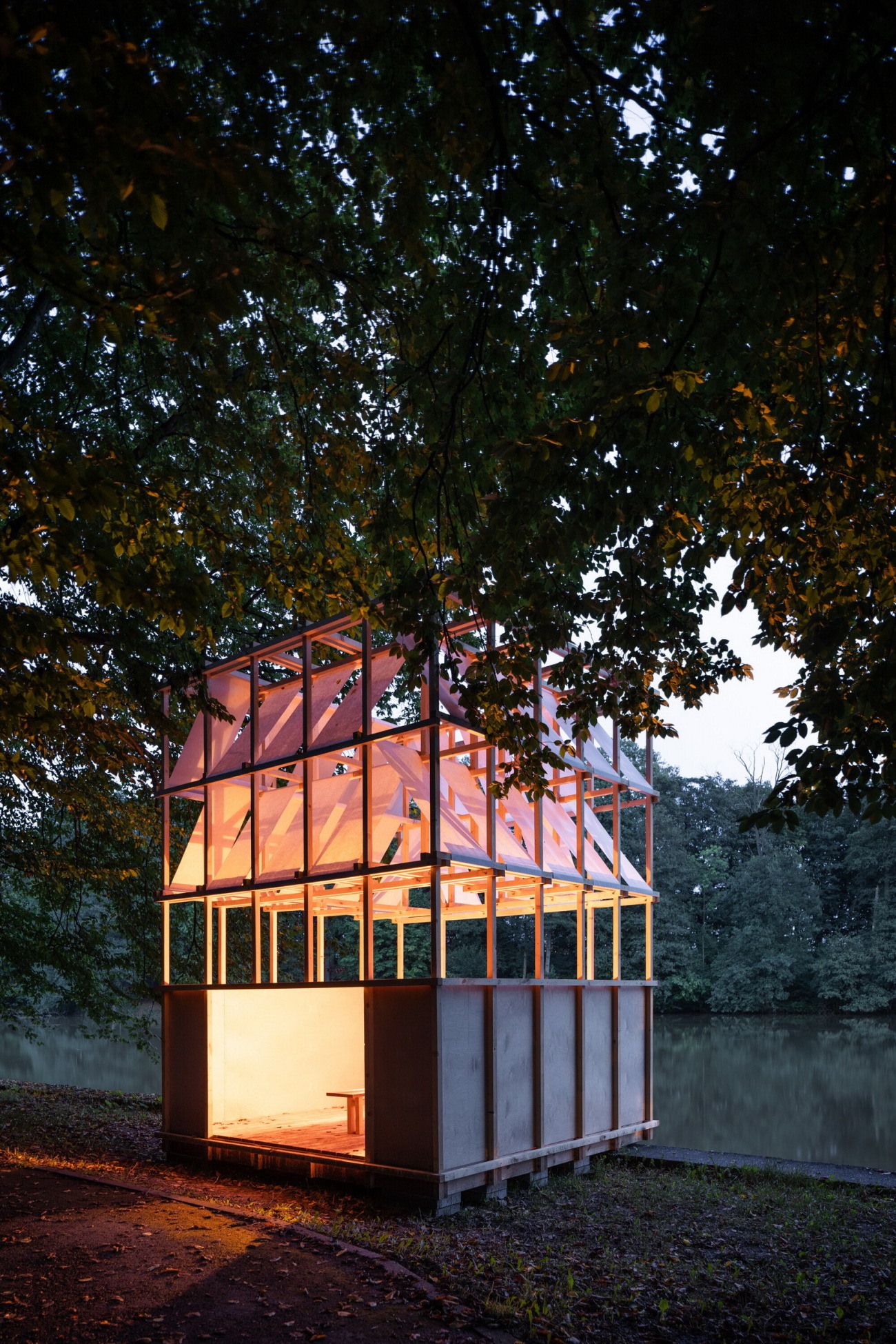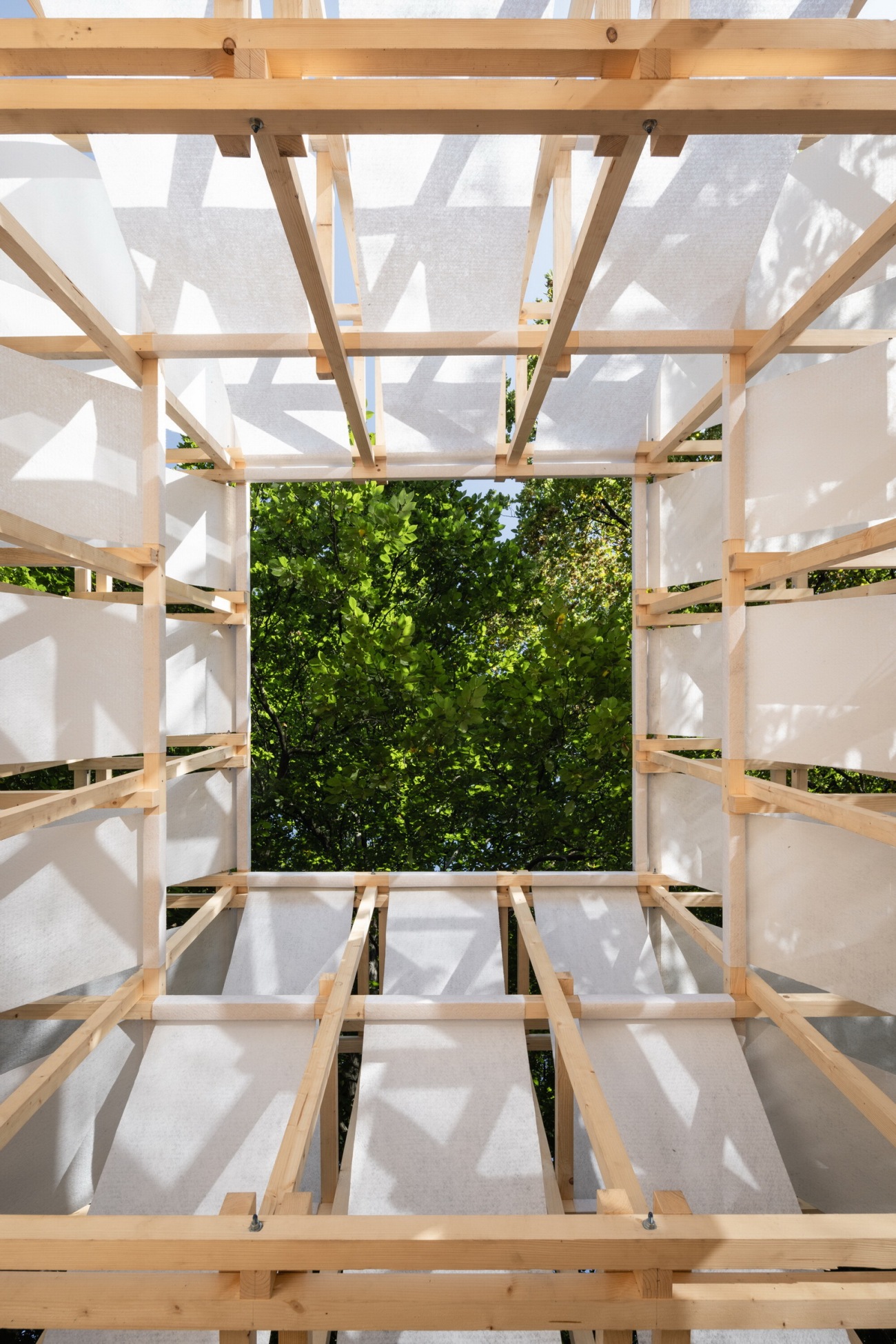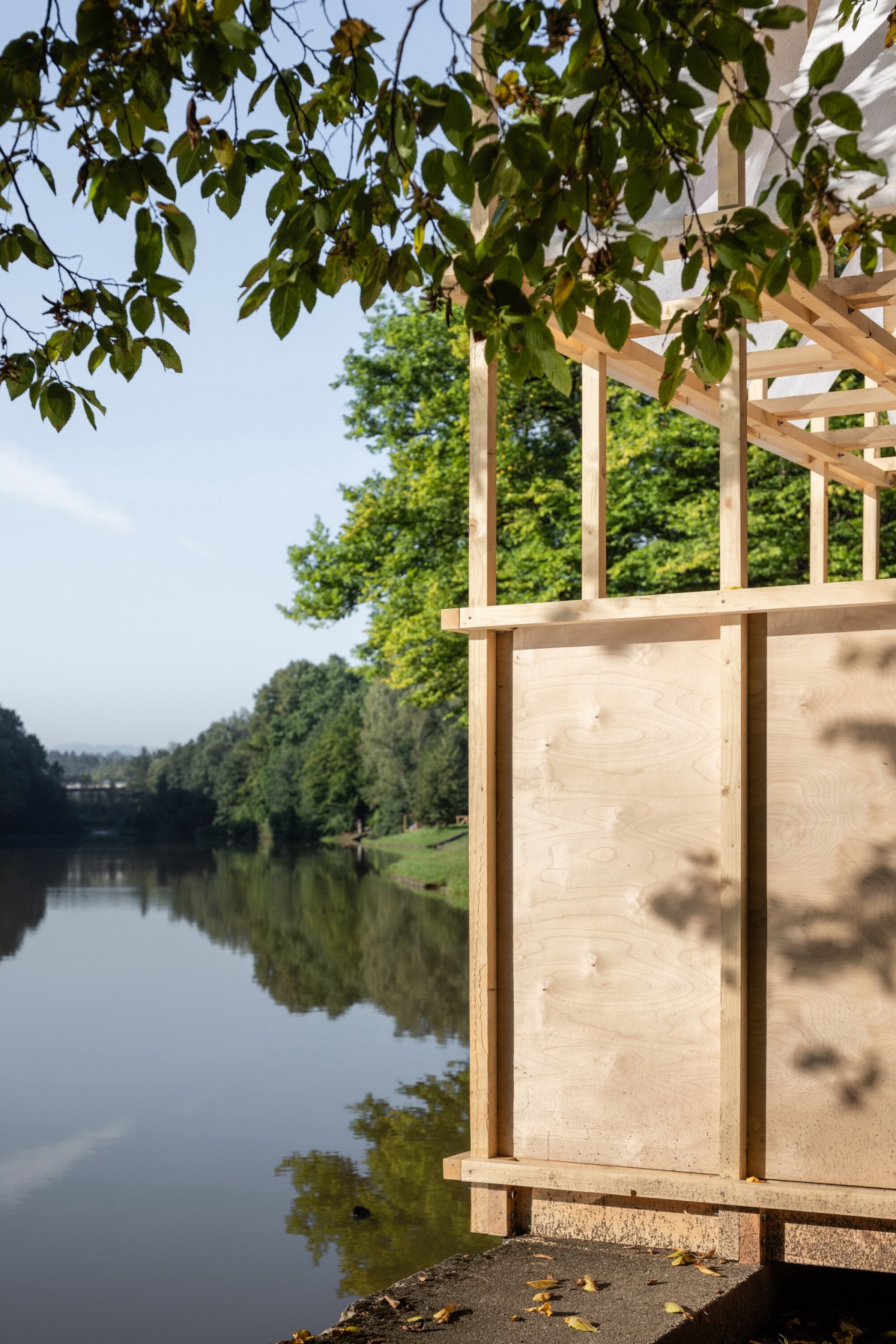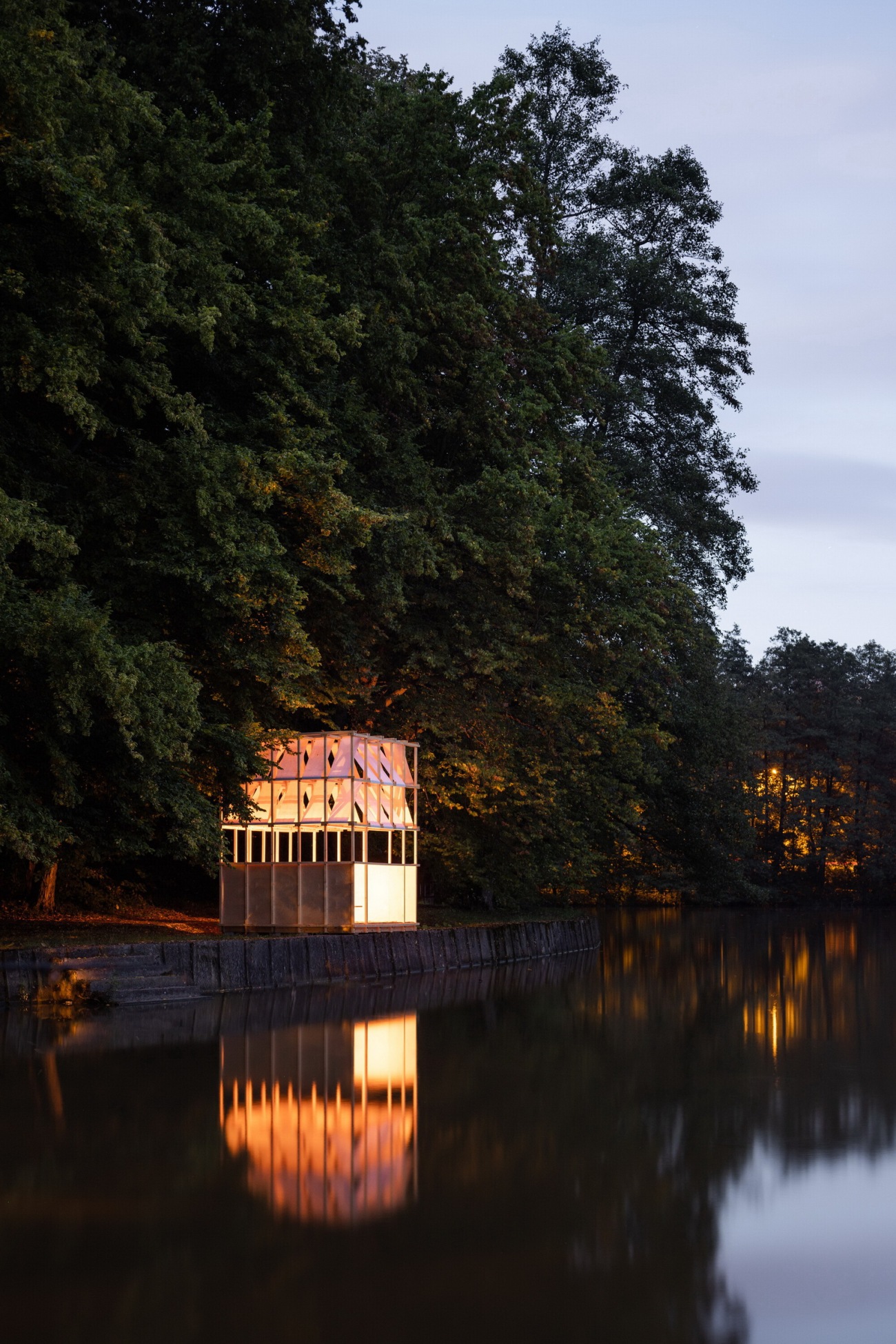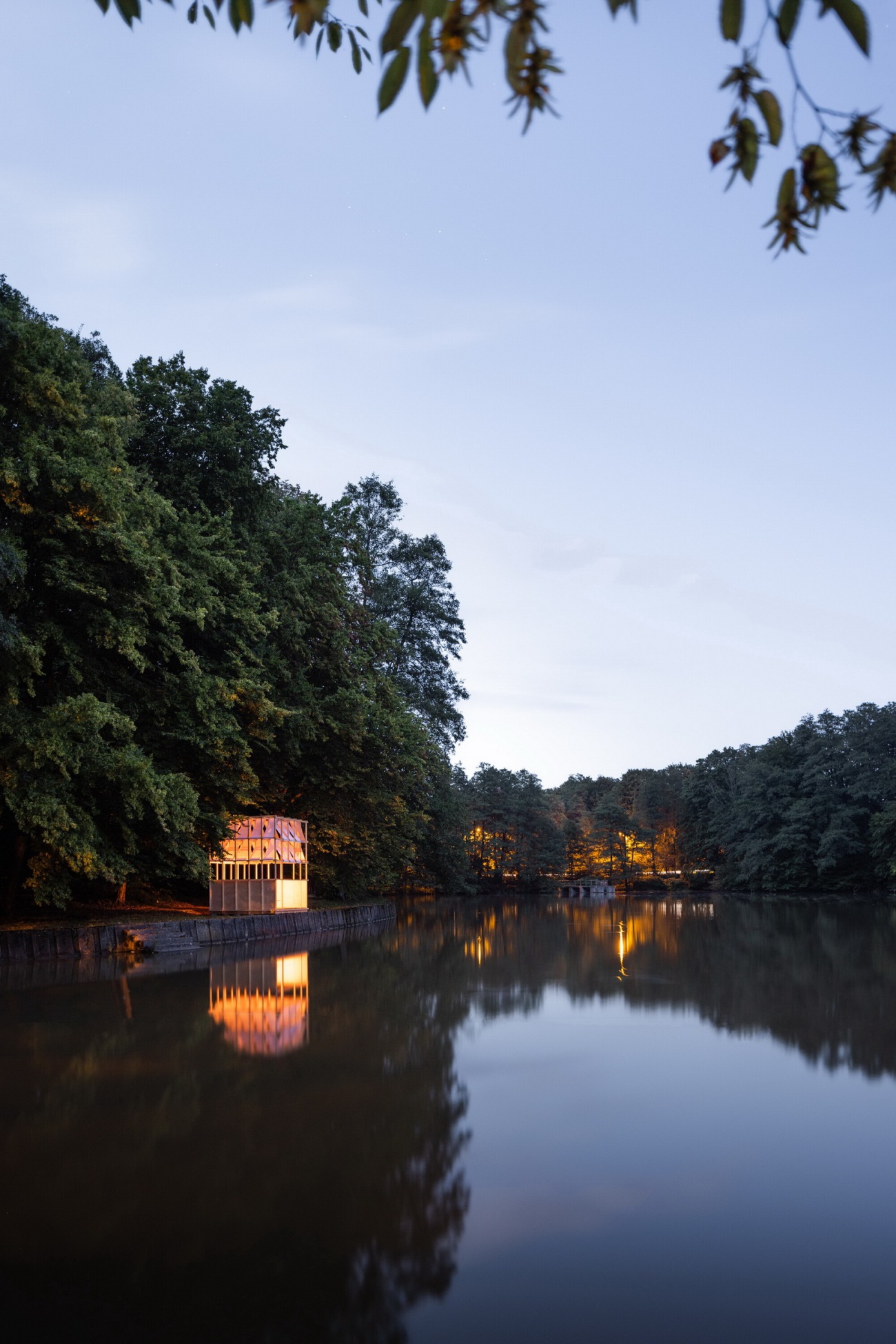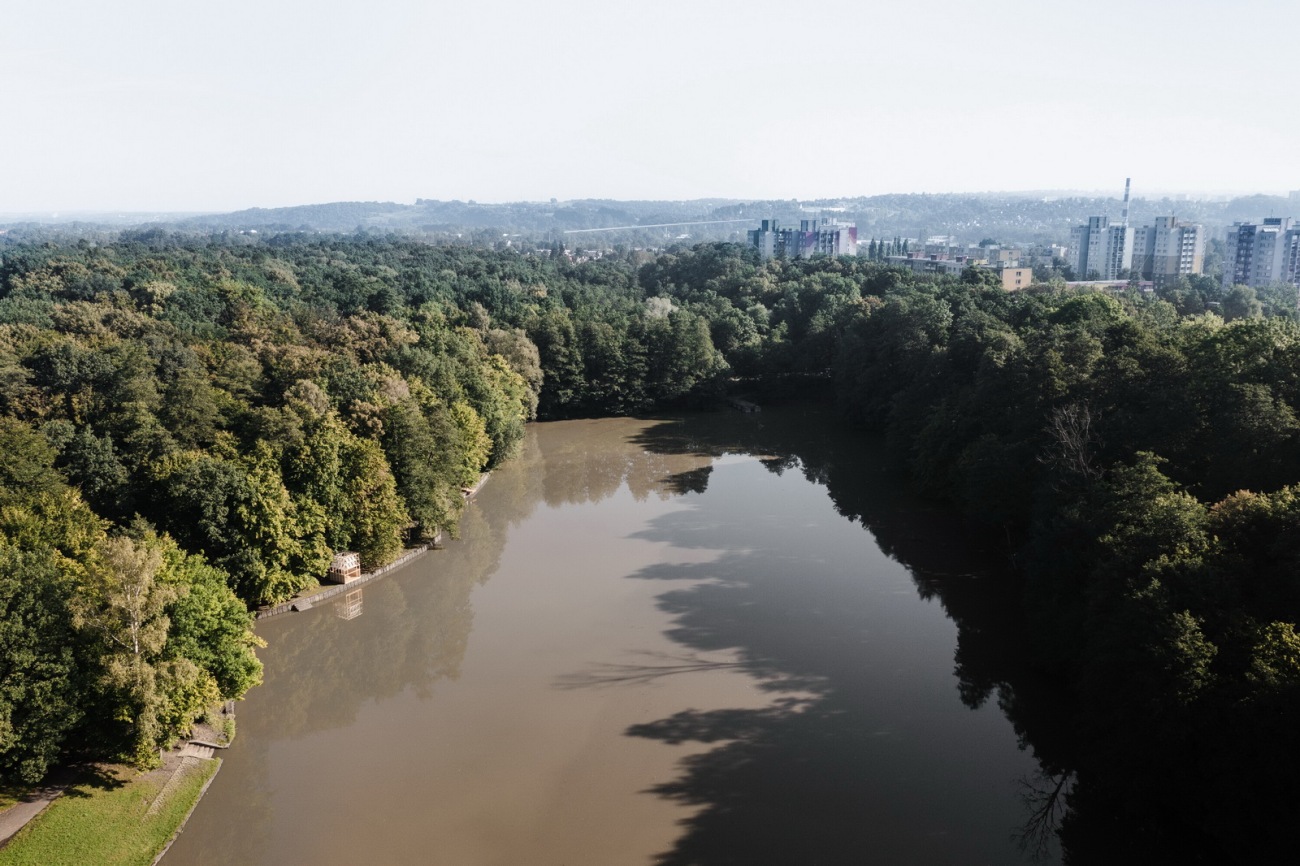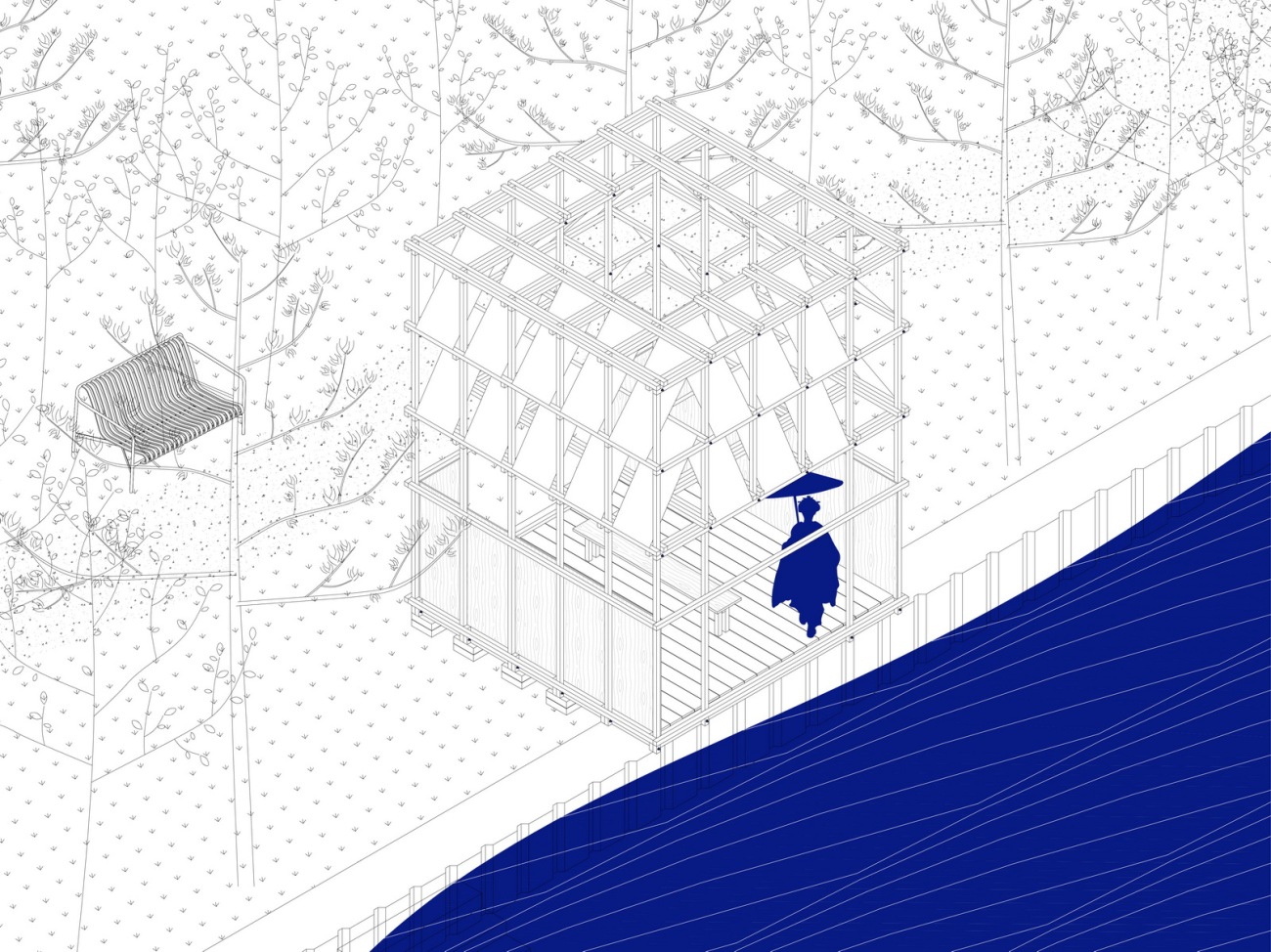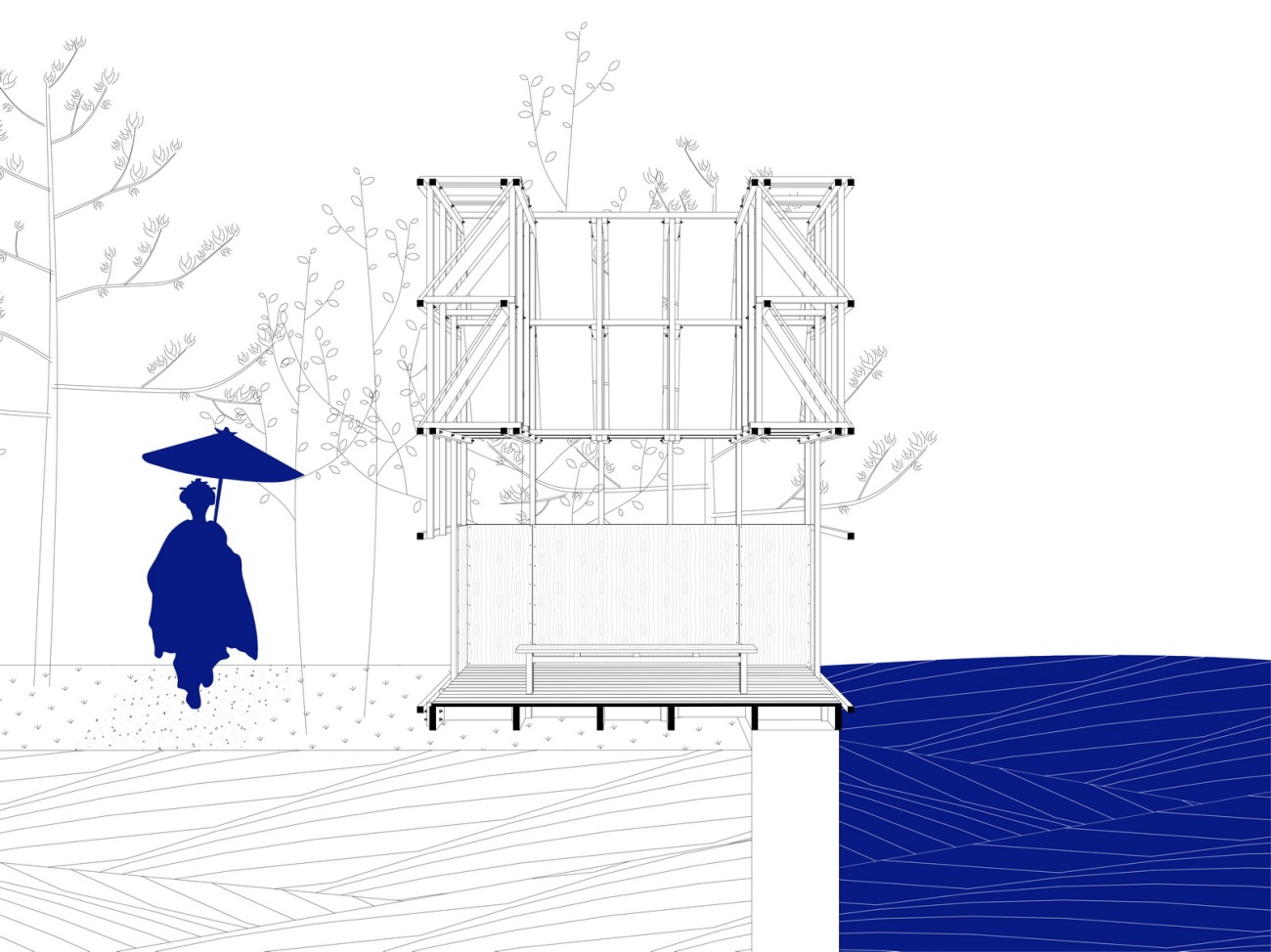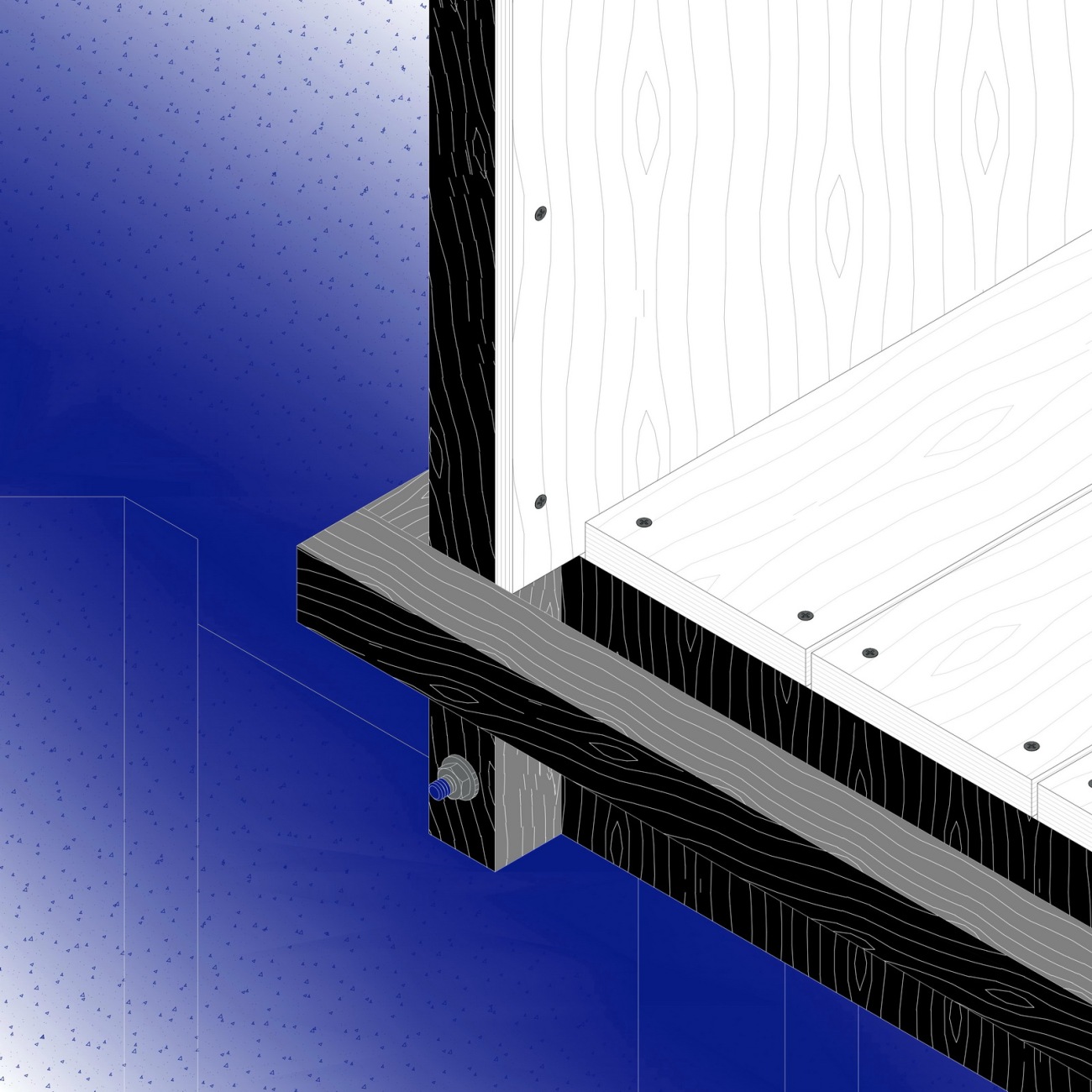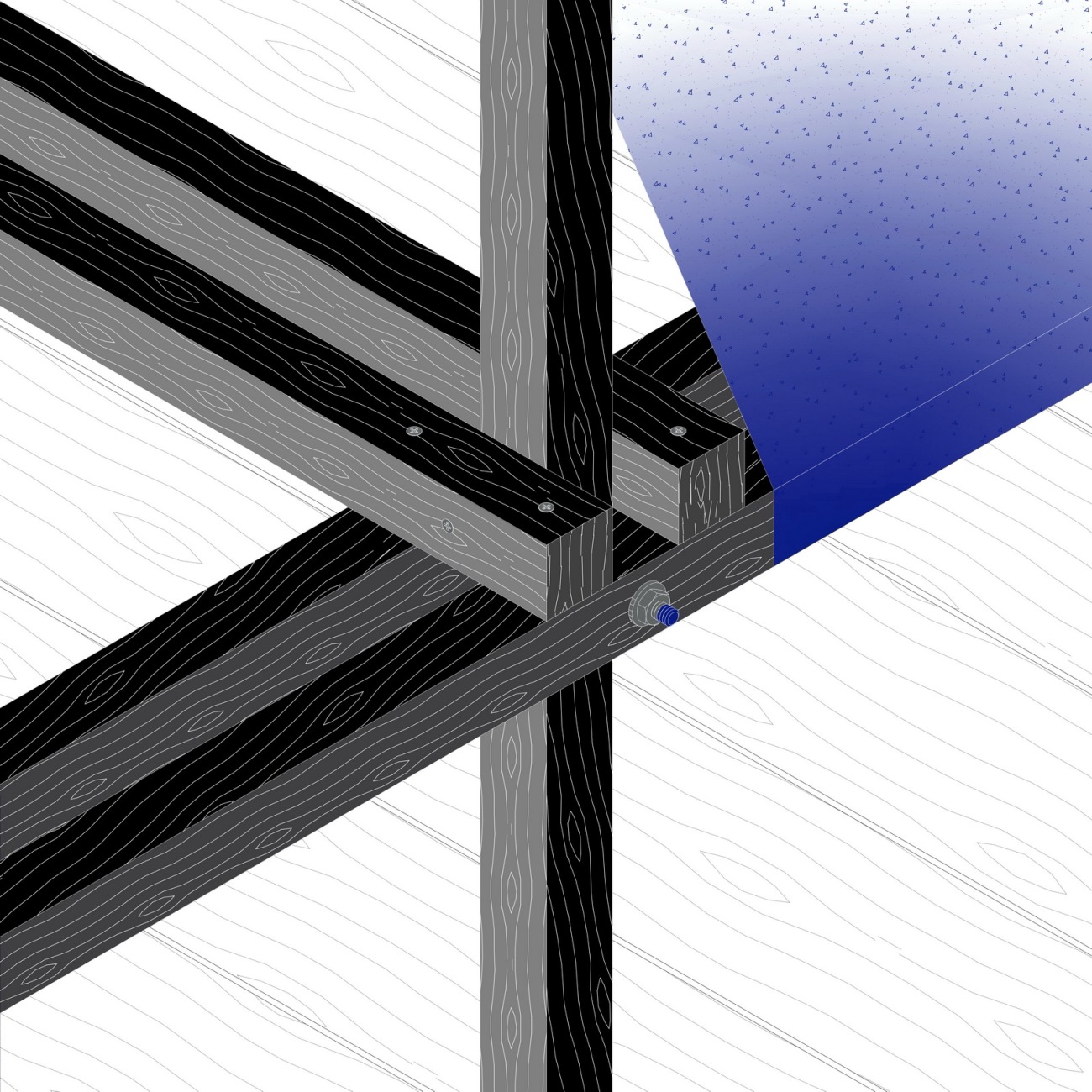| 公司: | GRAU architects | 类型: | 景观 |
|---|---|---|---|
| 地区: | 捷克共和国 | 标签: | 构筑物 |
位于Český Těšín堤岸边的茶亭作为“Mood for Wood”国际研讨会的一部分,是对公共空间的干预。在概念的思考上,我们从日本传统的茶馆建筑入手,用当代的表达方式进行呈现。我们采用简单的设计原则,将木制元素连接起来,创造出复杂的静态结构。
The tea pavilion located on the bank of the dam in Český Těšín was created as an intervention in public space as part of the Mood for Wood international workshop. When thinking about the concept, we start from the traditional Japanese architecture of tea houses rendered with contemporary means of expression. We work with a simple design principle of connecting wooden elements that create a complex static structure.
茶亭邀请人们近距离体验自然,将游客的注意力集中于水库的景色、声音与动态之中。它促使行人停下来,放慢脚步,欣赏无尽的树梢景色,无边无际的平静水面上的清晰视野,以及隔离周围日常生活的喧嚣。
The pavilion invites people to a close experience with nature, focusing visitors' attention on the water reservoir - views, sounds, movements. It forces a person to stop, to slow down thanks to the endless view into the treetops, the defined view of the boundless calm water surface and the gentle closure from the surrounding bustle of everyday life.
茶馆的内部可以舒适地容纳6个人,在进行茶道时面对面地围坐在桌子旁,这给了茶道一种亲密的感觉。微妙、轻盈、开放的结构是在呼应传统的日本室内结构,同时也引入了现代元素,使茶亭和谐而精致地融入周围的环境。
The interior of the pavilion comfortably accommodates 6 people, sitting face-to-face around the table during the tea ceremony, which gives the ceremony a certain impression of intimacy. The subtle/light, open construction refers to the traditional Japanese interior but brings modern elements into it. It fits harmoniously and delicately into the surrounding environment.
一些传统茶道的规则被运用到最终的设计中。当进入茶亭内部时,每个游客必须弯腰从亭子的最低的横梁下通过,这是指日本茶室中的“躙口(niriji-guchi)”,象征着所有茶道参与者的平等。同时,它也将人们的视线引向水面。茶亭的中间有一张矮桌,邀请游客跪坐于地面,这也是日本文化的习俗。茶亭的下部用胶合板加固,提供了一种隐私感,并与外部噪音分离。开放的入口框架让人可以看到内部空间,使路人也可以看到正在进行的茶道。
Several rules of the traditional tea ceremony were transferred to the final design. When entering the interior, each visitor must bend down to pass under the lowest horizontal beam of the structure, which refers to the niriji-guchi door, a symbol of the equality of all participants in the ceremony. At the same time, upon entering, a rectifying view opens up attention to the water reservoir. A low table in the middle of the layout invites visitors to sit on their knees as is customary in Japanese culture. Stiffening of the lower part of the structure with plywood boards provides a feeling of privacy and detachment from exterior noises. The open entrance frame allows a view into the interior and passers-by can see the tea ceremony in progress.
茶亭内的桌子可以使它在茶道中或作为长凳时使用,提供一个坐着和安静沉思的地方,从而遵循日本注重简约、精致的审美意识形态。亭内的桌子成为了唯一的中央家具,能使茶道的参与者们围桌而坐,营造一种亲密的氛围。茶亭具有多功能的特点,除了可以体验茶道,它还是一个令人舒适的夏日凉亭,可以欣赏到舒缓的自然景观。其方形的平面设计简约,通过运用一些简单的元素描绘了自然中事物与人的形象。
The height of the table gives it versatility when used both during the tea ceremony or as a bench offering a place for sitting and quiet contemplation, thus following the Japanese ideology focused on simplicity and aesthetic sophistication. The table becomes the only central furniture of the pavilion, its depth allows the participants of the ceremony to sit in close proximity with a feeling of mutuality. The pavilion has a multifunctional character and, in addition to the tea ceremony, it can also function as a pleasant summer pavilion with soothing views of nature. The square-shaped floor plan refers to simplicity, and the use of primary elements depicts the symbol of matter and man.
茶亭的结构基于3×3米的平面,高度为4米,这是方形截面的云杉木棱柱结构的最高高度,也是茶亭所允许的最大高度。原始的木质元素与柔软的织物相辅相成,带来舒适的感觉,保持茶亭一直是简约的,因此它不会分散茶道时人本身的注意力,使其形成平和宁静的状态。
The structure of the pavilion is based on a plan area of 3 x 3 m with a height of 4 m, which is also the structural height of wooden spruce prisms of square cross-section and the maximum permitted height of the pavilion. The raw wooden elements are complemented by a soft fabric that brings a feeling of coziness, but keeps the pavilion still minimalist, so that it does not distract from the ceremony itself, from achieving a sense of peace and harmony.
茶亭还使用了云杉地板、桦木胶合板和屋顶土工布。亭子的主题结构以传统茶亭的形状为基础,使对角线固定的织物与桦木胶合板封闭的两面墙一起,创造了一种隐私感,并使房屋避免风吹日晒等天气的影响,但同时框架结构保持了通风和足够开放,与外部连接,并创造了超越传统的景观。两层的纺织品为茶亭带来了一定的趣味性,这也是为了呼应传统的日本建筑。
Other materials used are spruce floor planks, birch plywood and roof geotextile. The mass of the pavilion is based on the shape of traditional tea pavilions. Diagonally fixed fabric together with closing two side walls with birch plywood create an impression of privacy and protection against weather conditions such as sun and rain, which the house provides, but at the same time the frame structure remains airy and open enough to allow a connection with the exterior and the creation of non-traditional views. Textiles in two levels bring a certain play to the pavilion, which is meant to evoke traditional Japanese architecture.
▽轴测图,axonometric drawing.
▽剖面图,Section.
▽结构细节图,Structural Detail Drawing.
Project Name: Tea House Pavilion
Project location: Czech Republic (49°44’48.9″N 18°36’07.9″E Hrabinka Lake, Český Těšín)
Project year: 2022
Completion year: 2022
Gross Floor Area: 9 m²
Dimensions: 3 x 3 x 4 m
Cost : 15 000 €
Studio: GRAU architects
Author: Andrej Olah, Filip Marčák, Jana Filípková, Alexandra Májska
Contact E-mail: hello@grau.sk
Website: www.grau.sk
Social media: www.instagram.com/grauarchitects
www.facebook.com/grauarchitects
Studio address: Blumentálska 1, 811 07 Bratislava, Slovakia
Co-author: [students, workshop participants] Julia Kurnik, Alicja Łosik, Alexandra Gospodarek, Katarzyna Owczarska, Maria Pawłova, Maciej Kuratczyk, Michał Teodorczyk, Jan Chmurski
Client: Mood for Wood
Client’s e-mail: moodforwood.workshops@gmail.com
Client’s website: www.moodforwood.com
Project website: www.labzdra.linuxpl.eu/MoodForWood2/wordpress/tea-pavilion
Photographer: Matej Hakár, info@matejhakar.com, www.matejhakar.com
更新日期:2023-04-17 18:28:32
非常感谢 GRAU architects 带来的精彩项目, 查阅更多Appreciations towards GRAU architects for sharing wonderful work on hhlloo. Click to see more works!
